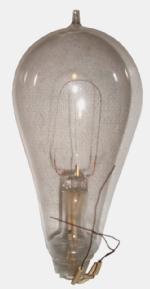
EdisonEffectLamp
|
|
|||||||||||||||||||||||||||||||||||||
|
Hits: 2552 Replies: 0
EdisonEffectLamp (EdisonEffectLamp)
|
|
|
Fin Stewart
02.May.12 |
1
EDISON EFFECT LAMP Shortly after Thomas Edison invented and patented his successful incandescent lamp in October 1879, he was concerned about a black deposit which formed inside the glass bulbs after some use. He began a series of experiments to find out why this was happening. He used the standard baseless 100 volt 16 candlepower carbon filament lamp of the day and in these. He placed a metal “shield” between the filament horseshoe, with a separate leading-in wire. He found that, when connected to a galvanometer, current would flow on the positive side but not if it was reversed to the negative. He called this an Electrical Indicator (for measuring currents) and applied for a patent on the device in November 1883. The patent was issued in October 1884. He did not follow through with the invention but several were on display at the International Electrical Exhibition held in Philadelphia from September 2 to October 11, 1884. Among those present at the exhibition was William Henry Preece, then chief electrical engineer of the British Post Office. Preece was so impressed with Edison’s display to a point where in the following week, Edison had several of the regulator lamps made for him, There were at least nine made, and in various forms. Preece returned to England with these and performed his own experiments over the next few months. He presented a paper to the Royal Society in London on March 18th, 1885 detailing these. According to the illustrations in the paper, the lamps were the same style as Edison had used - baseless 100 volt 8 and 16 candlepower carbon filament lamps, with an added electrode. These were in two styles - 1) simple glass bulbs with the three wires protruding from the base and electrodes of copper, iron and carbon. There was one of which had two electrodes. 2) glass bulbs with a tubular attachment, containing the electrode, about 15 mm diameter and of various lengths and placed either on the top, or the side of the bulb. Lamp no 5 of these had electrodes in three tubes. In the paper Preece presented, he gave detailed calculations for each of seven experiments he conducted with these lamps. He used a range of voltages, from 40 to 120. In most of these, he encountered “blue glow” when the lamps were run at high voltages. He measured filament resistance, E.M.F., current resistance in milliamps and resistance of the “shunt” incorporated in the circuit. His conclusions included the belief that the lamps were not suitable for regulating electric light as Edison had hoped. It was for John Ambrose Fleming to take up further investigation of these lamps and adapt them for wireless receiving early in 1900 and his subsequent invention of the “Oscillation Valve” What became of Preece’s lamps, or where they were stored is unclear but it is believed one was broken in the early 1970’s. Further provenance of the remaining lamps indicate that they may have been sold at auction in London in the early 1980’s, though this information, if known, is a closely guarded secret. It is confirmed that several genuine Edison Effect Lamps were in a private collection in the UK and the lamp in the photo is one of these - an 8 candlepower version. A photo of an Edison Effect Lamp of 1884 shows the lamp fitted with a standard Edison screw base of the time, with the electrode wire coming out through the plaster base cement, adjacent to the glass bulb. This wire is insulated to stop it coming into contact with the brass base shell It is not known how long these were manufactured. References: 1) “Saga of the Vacuum Tube” by Gerald J Tyne, Howard W Sams & Co., Inc, 1977. Pages 30 - 34 and 41 & 42. 2) Paper “On a Peculiar Behaviour of Glow Lamps when raised to High Incandescence” by William Henry Preece F.R.S., Royal Society, March 18th, 1885 - pages 219 to 230. 3) Edison’s Trial Evidence Lamps, Christies Auction catalogue, December 13th, 2006. Lamp no 20 and subsequent notes.
|
|
Hits: 2412 Replies: 0
EdisonEffectLamp (EdisonEffectLamp)
|
|
|
Konrad Birkner † 12.08.2014
30.Apr.12 |
1
This is now obsolete and can be erased. |
End of forum contributions about this tube
| Data Compliance | More Information |

